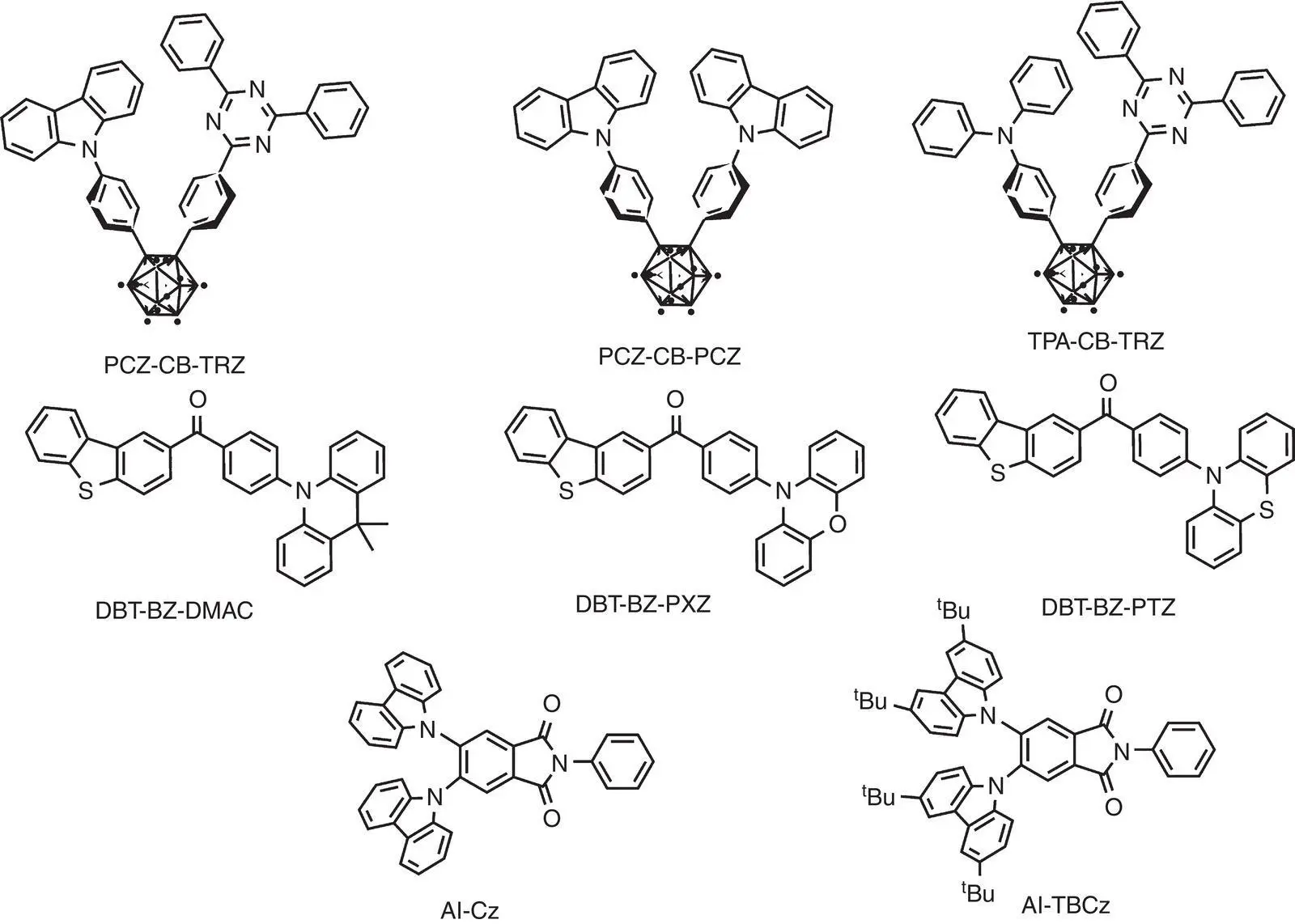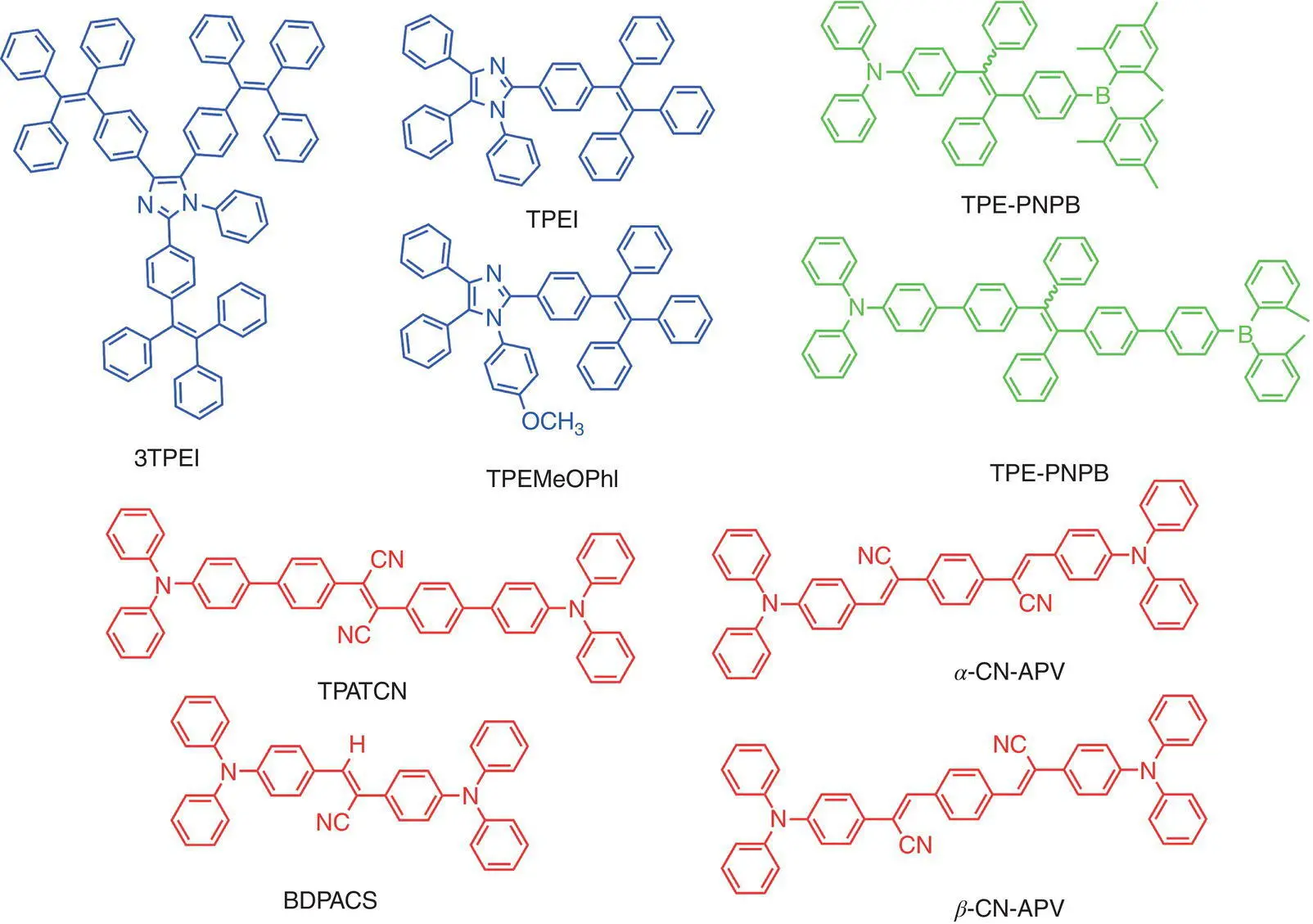
Figure 1.6 Aggregation‐induced phosphorescent emitters.
1.3.2 Aggregation‐induced Delayed Fluorescent Emitters
TADF or E‐type delayed fluorescent emitters can also achieve 100% IQE, and these emitters tend to have a small energy between S 1and T 1states (Δ E ST) [21] to enable upconverting triplet excitons into singlet ones via the process of RISC under external heat [113]. Early in 1961, Parker and Hatchard have already discovered this phenomenon in the eosin dye [114]; however, it is not until 2009 when Adachi group utilized the TADF emitters Sn(IV)‐complexes to fabricate the first TADF OLEDs [21]. In last decade, the TADF emitters have seen a rapid progress in terms of both category [115] and efficiency [116], and they are on their way for replacing phosphorescent emitters and conventional fluorescent materials, referred to as the third‐generation emitters for OLED devices [117]. Among these emitters, the emitters with both TADF and AIE propriety have already been introduced and have attracted tremendous attention, because they can prepare highly efficient OLEDs without doping process [92].
The first emitters with both AIE and TADF properties applied in OLED devices were reported by Yasuda et al. in 2016, as organic–inorganic compounds of o ‐carborane derivatives PCZ‐CB‐TRZ, PCZ‐CB‐PCZ, and TPA‐CB‐TRZ( Figure 1.7), with emission peaking at wavelengths of 557, 624, and 571 nm, respectively, and also high solid‐state PLQYs of 97, 55, and 94% in neat films, respectively, compared with their PLQY below 3% in solution. Their nondoped OLED devices can reach the maximum EQEs of 11, 10.1, and 9.2%, respectively [118]. Zhao and Tang et al. synthesized and reported a series of AIE and TADF luminogens, as AIDF emitters [119]. For example, they reported three unsymmetrical D‐A‐D′ structured AIDF emitters of DBT‐BZ‐DMAC, DBT‐BZ‐PXZ, and DBT‐BZ‐PTZ( Figure 1.7), and their doped OLEDs exhibited highest EQE of 19.2% with larger efficiency roll‐off, while their nondoped counterparts showed the data of up to 14.2%, but with slight efficiency roll‐off [120, 121]. Chen et al. reported another AIE‐TADF materials AI‐Czand AI‐TBCz( Figure 1.7), based on which OLEDs gave stable emission and low efficiency roll‐off, with maximum EQEs of 23.2 and 21.1%, respectively [122].

Figure 1.7 Chemical structures of aggregation‐induced delayed fluorescent emitters.
1.3.3 Hybridized Local and Charge Transfer Materials Aggregation‐induced Emissive Emitters
Different from Kasha’s rule, “hot exciton” process can happen between higher, excited triplet states to emissive singlet T m→ S n( m ≥ 2), which was discovered in 1962 [123]. This process with 100% IQE in theory was often accompanied by HLCT excited state, where LE state decays fluorescently, while CT state upconverted from 3CT to 1CT and then to emissive 1LE state, as a result of close LE and CT states [28–31]. Ma et al. first reported several HLCT emitters of donor–acceptor (D–A) structures, and the related OLEDs’ excellent EL performance [28]. As the AIE characteristics also grafted into the HLCT materials, it enabled these emitters to have high efficiency in aggregated state, with spectrum from blue to green and red.
Our group utilized the most common AIE‐active group of TPE to combine with imidazole, and three blue novel emitters TPEI, TPEMeOPhI, and 3TPEIwere prepared ( Figure 1.8), showing both HLCT and AIE behaviors. Their nondoped OLEDs can be fabricated through facile process, with medium maximum EQE of 2.41, 2.16, and 3.13%, and slight efficiency roll‐off [124]. Tang et al. also took advantage of TPE moiety to prepare two green AIE‐active emitters TPE‐NBand TPE‐PNPB( Figure 1.8), both of which exhibited double slops of stokes shift versus different solvent parameters, suggesting the existence of both LE and CT state. The OLED based on the emitter of TPE‐PNPBshowed better EL performance, with maximum EQE of up to 5.35% as a result of weaker D–A interaction [125]. With regard to the red HLCT‐AIE emitters, the TPE’s CN derivatives were usually applied as a high‐efficient luminescent building block, based on which Lu et al. prepared TPATCN( Figure 1.8) with another building of 2,3‐ bis (4‐bromophenyl)fumaronitrile. The density functional theory (DFT) calculation showed larger energy gap between T 2and T 1and smaller energy splitting between T 2and S 1, which prohibited the intersystem conversion and activated the “hot exciton” process. The nondoped OLED based on TPATCNexhibited strong NIR emission with maximum EQE and luminance of 2.58% and 7025 cd/m 2, respectively [126]. The contribution of AIE property to the highly efficient HLCT mechanisms were further confirmed by Wang et al. through the QM/MM method [127]. Similarly, based on the same AIE‐active moiety, Yuan and Zhang et al. prepared AIE‐HLCT emitter of BDPACS( Figure 1.8). Its nondoped OLED could only reach the maximum EQE of 0.41%, as a result of exciplexes or excimers formed, while the doped OLED with BDPACSembedded into host of 2‐methyl‐9,10‐di(2‐naphthyl)anthracene ( MADN) exhibited significantly enhanced maximum EQE of 6.8% [128]. Through substitution of the vinylene groups with CN groups at different positions, two isomers of α‐CN‐APVand β‐CN‐APV( Figure 1.8) were prepared by Ma et al., and the isomer with closer intermolecular stacking showed higher maximum EQE ( β‐CN‐APV: 5.3%) [129].

Figure 1.8 The structures of hybridized local and charge transfer materials aggregation‐induced emissive emitters.
1.4 Conclusion and Outlook
OLED technology has experienced a rapid progress in last few decades, and numerous emitters of various structures with different photophysical mechanisms have been applied to this area. Due to OLEDs’ nature of solid‐state lightening, the emitters’ aggregated states also play a vital role in the performance of OLEDs, especially for the efficiency and luminance. The ACQ properties have the drawbacks of quenching and lowering the EQE of OLEDs; therefore, in order to overcome ACQ behaviors, the doping technology was often resorted to, causing complex process and unstable performance for the devices. In contrast to ACQ, AIE property means that emitters have increased emission in aggregated states, enabling them to prepare nondoped OLED devices, still with high efficiency and luminance. Till now, numerous AIE emitters have been applied in OLED devices; therefore, in this review, we mainly demonstrated the emitters based on AIE integrated with different photophysical mechanisms and their applications in OLED devices. So far, most of AIE emitters are traditional fluorescent. Due to the facile molecule design, the traditional fluorescent AIE emitters have covered wide range of spectrum, and blue to green from red. And even a lot of white OLEDs based on these emitters have been fabricated. However, due to the theoretic EQE limitation of 5% for traditional AIE emitter‐based OLED, AIE property has been combined with other high EUE photophysical mechanisms to prepare highly efficient OLED emitters. Among these emitters, the AIPE emitters with both AIE property and phosphorescent emission were developed first, but with only little progress regarding the emitters reported and the related EQE achieved. The AIDF and HLCT‐AIE materials started quite recently, but with both numerous emitters and high EQE efficiency reported in comparison to their nonAIE‐active counterparts.
Читать дальше















